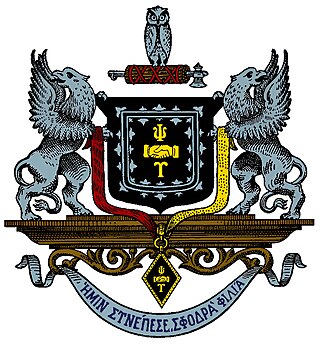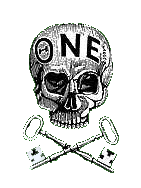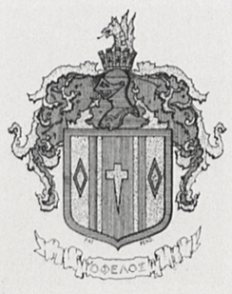Related Research Articles

Delta Kappa Epsilon (ΔΚΕ), commonly known as DKE or Deke, is one of the oldest fraternities in the United States, with fifty-six active chapters and five active colonies across North America. It was founded at Yale College in 1844 by fifteen sophomores who were discontented with the existing fraternity order on campus. The men established a fellowship where the candidate most favored was "he who combined in the most equal proportions the Gentleman, the Scholar, and the Jolly Good Fellow."

Psi Upsilon (ΨΥ), commonly known as Psi U, is a North American fraternity, founded at Union College on November 24, 1833. The fraternity reports 50 chapters at colleges and universities throughout North America, some of which are inactive.

Alpha Sigma Phi (ΑΣΦ), commonly known as Alpha Sig, is an intercollegiate men's social fraternity with 181 active chapters and provisional chapters. Founded at Yale in 1845, it is the 10th oldest Greek letter fraternity in the United States.
Dartmouth College is host to many fraternities and sororities, and a significant percentage of the undergraduate student body is active in Greek life. In the fall of 2022, 35 percent of male students belong to a fraternity and 36 percent of students belong to a sorority. Greek organizations at Dartmouth provide both social and residential opportunities for students and are the only single-sex residential option on campus. Greek organizations at Dartmouth do not provide dining options, as regular meal service has been banned in Greek houses since 1909.

Delta Phi (ΔΦ) is a fraternal society established in Schenectady, New York, on November 17, 1827. Its first chapter was founded at Union College, and was the third and final member of the Union Triad. In 1879, William Raimond Baird's American College Fraternities characterized the fraternity's membership as being largely drawn from the old Knickerbocker families of New York and New Jersey.
While the traditional social fraternity is a well-established mainstay across the United States at institutions of higher learning, alternatives – in the form of social fraternities that require doctrinal and behavioral conformity to the Christian faith – developed in the early 20th century. They continue to grow in size and popularity.

Theta Nu Epsilon is a sophomore class society. Founded at Wesleyan University in 1870 as a chapter of Skull and Bones, the society expanded into a new national organization. It accepts members regardless of their fraternity status.

Theta Upsilon Omega (ΘΥΩ), was a national collegiate fraternity in the United States. Representatives of several local fraternities at a December 1, 1923 meeting of locals, organized by the National Interfraternity Conference, determined to form a new national through amalgamation, resulting in the creation of Theta Upsilon Omega on May 2, 1924.
The North American fraternity and sorority system began with students who wanted to meet secretly, usually for discussions and debates not thought appropriate by the faculty of their schools. Today they are used as social, professional, and honorary groups that promote varied combinations of community service, leadership, and academic achievement.
The term Triad is used to designate certain historic groupings of seminal college fraternities in North America.

Alpha Kappa Pi (ΑΚΠ) was an American collegiate social fraternity founded in 1921 at the Newark College of Engineering. In 1946, it merged with Alpha Sigma Phi.

Theta Sigma Upsilon (ΘΣΥ) was an American sorority founded on March 25, 1921 at Emporia State University. It chartered 23 chapters in the United States. The sorority merged with Alpha Gamma Delta on June 29, 1959.
References
- ↑ William Emery Decrow (1882) Yale and the "City of Elms" pp. 35–36, Wright and Potter Printing Co., Boston (digitized by Google Books)